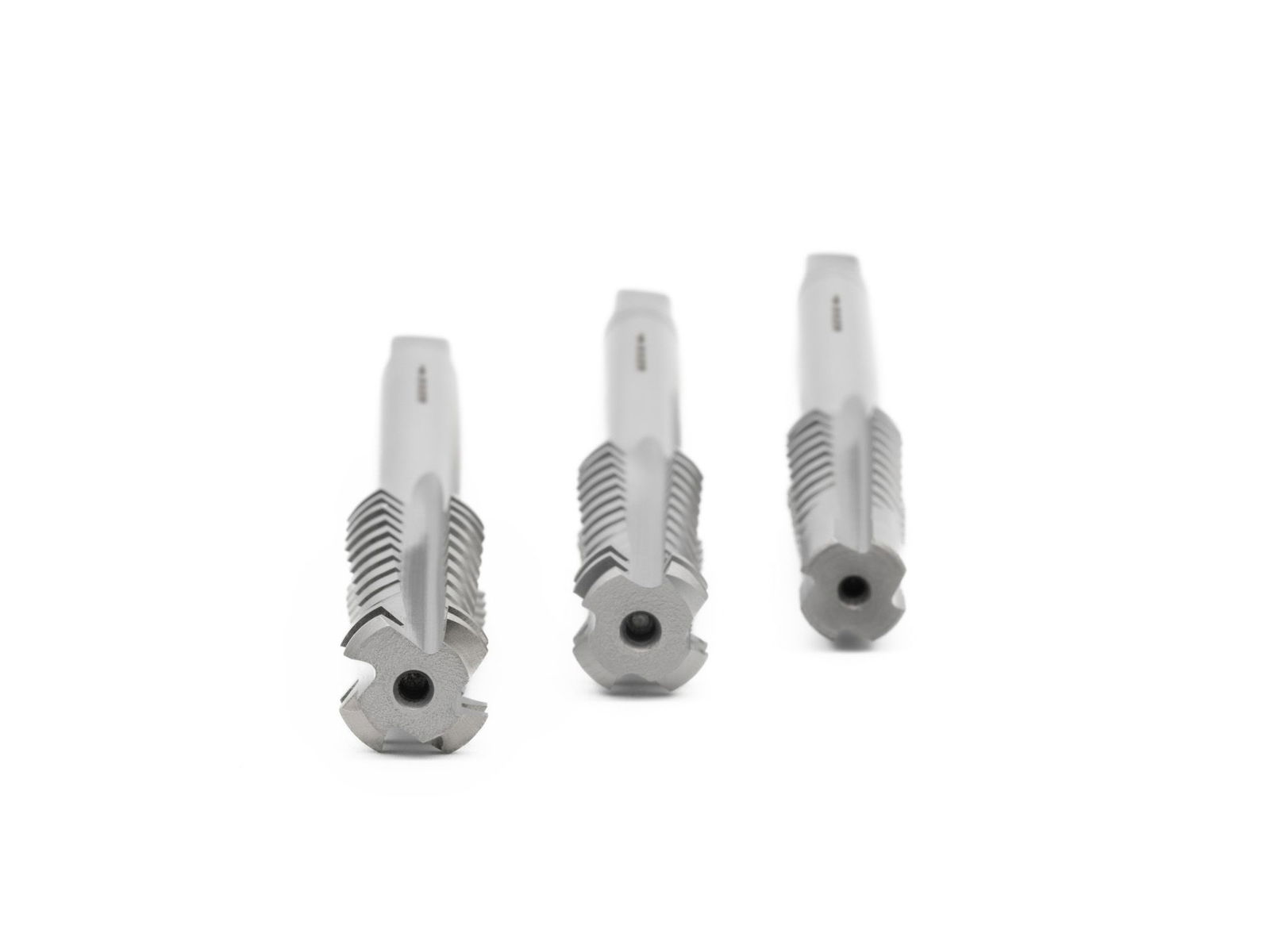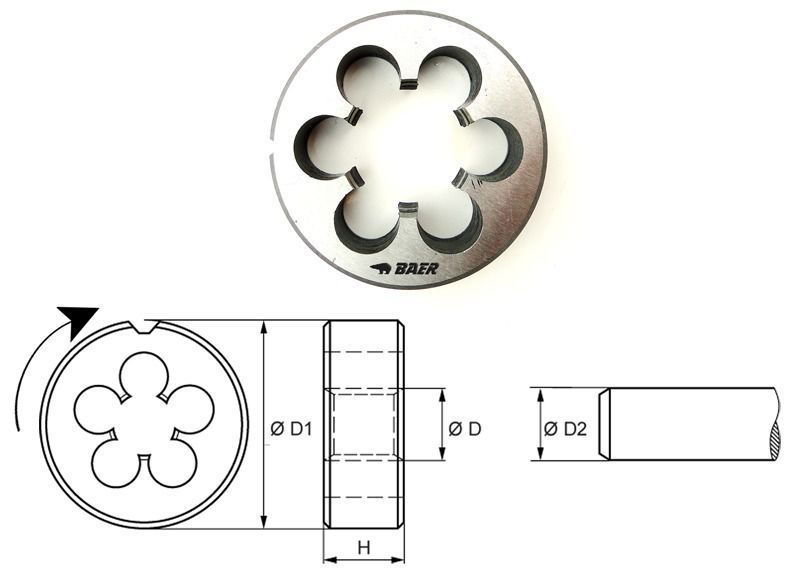BAER HSSG Hand Tap Set (3pcs.) TR 32 x 6
In stock
BAER HSSG Hand Tap Set (3pcs.) TR 32 x 6
The hand tap set consists of three taps and allows you to cut a finished thread with significantly reduced risk of breakage. The advantage of three-piece hand taps is that the respective parts of a set share the cutting power: The taper tap (No. 1) (marked with one ring) removes 65 per cent of the thread profile and the intermediate tap (No. 2) (marked with two rings) removes 85 per cent. Pre-cutting and reworking with the intermediate tap (No. 2) bring the thread into shape. In the last step, the finishing tap (No. 3) is used, which has no ring marking. Only this cuts the full and usable thread at the end. The division of labour between the three screw tap makes it easier to cut a straight and clean thread by hand.
Compared to the machine tap, the hand tap has a short shank. This allows you to cut internal thread by hand without jamming and can be operated with tap wrenches, tool ratchets or other holding tools with square drive.
The thread can be cut in a pre-drilled core hole.
Due to the short chamfer of the finish tap, the hand tap set can be used reliably and universally for through holes and blind holes.
As a rule, three-piece hand taps- sets are used for regular threads with coarse pitch, as the thread profile area is larger than for fine threads and the force effects on the taps are greater.
Dimensions
| Diameter |
32 |
|---|---|
| Pitch |
6 |
| Dimension |
TR 32 x 6,0 |
| Square |
20 mm |
Characteristics
| Product group |
Screw taps |
|---|---|
| Product type |
Hand tap sets |
| Thread standard |
TR: Trapezoidal thread according to DIN 103 |
| Tolerance |
7H |
| Direction |
Right |
| Standard |
Factory standard |
| Tensile strength at room temperature |
up to 900 N/mm² | 27.1 HRC |
| Material |
HSSG bright |
Technical information – Screw taps

26.25 mm

Through hole and blind hole up to 3 x D

Form C straight fluted

2-3 threads

Rarely occurs. Chips remain in flutes.

External cooling and lubrication

HSSG bright

up to 900 N/mm² | 27.1 HRC

7H
Applications
- Materials with good machinability up to 900 N/mm²
- Unalloyed and low-alloy steels
Technical drawing

| D1 |
TR 32 x 6 |
|---|---|
| D2 |
25 mm |
| L1 |
255 mm |
| L2 |
80 mm |
| Diameter |
32 |
| Square |
20 mm |
Application – Sample materials for taps
| Unalloyed construction steels | |
|---|---|
| 1.0035 | S185 (St33) |
| 1.0036 | S235JRH |
| 1.0038 | RSt37-2 |
| 1.0039 | S235JRG1+CR |
| 1.0044 | St44-2 |
| 1.0060 | E335 (St60-2) |
| 1.0116 | St37-3 |
| 1.0570 | St 52-3 |
| Alloyed construction steels | |
|---|---|
| 1.5415 | 15Mo3 |
| 1.5423 | 16Mo5 |
| 1.5622 | 14Ni6 |
| 1.7335 | 13CrMo44 |
| 1.7337 | 16CrMo44 |
| 1.7715 | 14MoV63 |
| Free-cutting steels | |
|---|---|
| 1.0711 | 9S20 |
| 1.0715 | 9SMn28 |
| 1.0718 | 11SMnPb30 |
| 1.0721 | 10S20 |
| 1.0723 | 15S20 |
| 1.0726 | 35S20 |
| 1.0737 | 9SMnPb36 |
| 1.0758 | 60SPb20 |
| Case-hardening steels | |
|---|---|
| 1.0401 | (C15) |
| 1.7016 | 17CR3 |
| 1.7131 | 16MnCr5 |
| 1.5919 | 15CrNi6 |
| Quenched and tempered steels unalloyed | |
|---|---|
| 1.0402 | C 22 |
| 1.1151 | C22E (Ck22) |
| 1.0503 | C 45 |
| 1.1191 | C45E (Ck45) |
| Cast steel | |
|---|---|
| 1.0420 | GS-38 |
| 1.5419 | GS-22 Mo 4 |
| 1.6750 | GS-20 NiCrMo3 7 |
| 1.7357 | GS-17 CrMo 5 5 |
| Malleable cast iron | |
|---|---|
| 0.8145 | EN-GJMB 450-6 |
| 0.8170 | EN-GJMB 700-2 |
| 0.8045 | EN-GJMW-450-7 |
| 0.8055 | EN-GJMW-550-4 |
| Pure copper low-alloyed | |
|---|---|
| 2.0240 | CuZn15 |
| 2.0265 | CuZn30 |
| Brass short-chipping | |
|---|---|
| 2.0401 | CuZn39Pb3 |
| Brass long-chipping | |
|---|---|
| 2.0321 | CuZn37 |
| 2.0335 | CuZn36 |
| 2.0360 | CuZn40 |
| Aluminum cast Si > 5-12 % | |
|---|---|
| 3.2161 | G-AlSi8Cu3 |
| 3.2163 | G-AlSi9Cu3 |
| 3.2381 | G-AlSi10Mg |
| 3.2583 | G-AlSi12(Cu) |
| Lamellar graphite cast iron | |
|---|---|
| 0.6010 | EN-GJL 100 (GG-10) |
| 0.6020 | EN-GJL 200 (GG -20) |
| 0.6025 | EN-GJL 250 (GG-25) |
| 0.6030 | EN-GJL 300 (GG -30) |
| Copper-tin alloy (bronze) short-chipping | |
|---|---|
| 2.1090.01 | G-CuSn7ZnPb |
| 2.1086.01 | G-CuSn10Zn |
| 2.1097 | G-CuSn5ZnPb |
| Pure copper, low-alloyed copper | |
|---|---|
| 2.0240 | CuZn15 |
| 2.0265 | CuZn30 |
Further information
- TR - Trapezoidal Thread DIN 103
- Designations, geometries and definitions on taps
- Thread tolerances of the internal thread
- Internal thread and core hole dimensions
- Tap Chamfer forms
- Comparison inch-mm
- Surface treatments on tapping tools
- Cutting speeds and lubrication/cooling
- Information about tapping
- Material table
Safety instructions
Login













